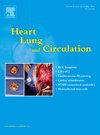Centralised Management System and Hot Transfer for ST-Elevation Myocardial Infarction in Western NSW: Closing the Gap in Current Models of Rural ST-Elevation Myocardial Infarction Care
IF 2.2
4区 医学
Q2 CARDIAC & CARDIOVASCULAR SYSTEMS
引用次数: 0
Abstract
Background
Rural vs metropolitan ST-elevation myocardial infarction (STEMI) patients experience delayed access to percutaneous coronary intervention (PCI). Existing New South Wales (NSW) Statewide Cardiac Reperfusion Strategy protocols provide thrombolysis and ambulance diversion for patients within 90 minutes of a PCI centre in regional and rural NSW. Rural patients presenting to non-PCI hospitals and those more than 90 minutes from PCI are not routinely, urgently, diverted under existing protocols.
Method
Western NSW Local Health District, covering 250,000 km2 and a population of 278,759, implemented a centralised management system (CMS) in 2019, in partnership with NSW Ambulance, utilising existing STEMI thrombolysis protocols and extending “drip and ship” protocols for “hot transfer” of all patients to the 24/7 PCI centre, by direct ambulance diversion up to 120 minutes by road, or via multi-stage transfer by road or air, or via interhospital transfer. Data for 2 years post-CMS was compared to historical controls. Time from first clinical contact (FCC) to reperfusion, FCC to PCI centre, major adverse clinical events and percentage of patients undergoing angiography within 24 hours were compared in “medium” (90–120 minutes) and “long” (>120 minutes) transfer zones, not covered by existing protocols.
Results
Outcomes were recorded for 274 patients before and 348 after CMS implementation (17% medium and 31% long transfer zones). Medium and long transfer zones had greater proportions of smokers and Indigenous patients than short transfer zones. There was significantly lower ambulance utilisation in the long (38%) compared with the short transfer zone (55%, p<0.001). In the long transfer zone, there were significant improvements in FCC to reperfusion (40 vs 48 minutes, p<0.05), FCC to PCI centre (296 vs 344 minutes, p<0.01), and angiography in 24 hours (77% vs 58%, p<0.01), with no significant differences in major adverse clinical events.
Conclusions
A rural STEMI CMS, with “hot transfer”, can deliver patients from a vast geographical area directly to a rural PCI centre. Patients furthest away, with the greatest risk profile, benefit the most. Extension of this program and development of 24/7 PCI in NSW rural cardiac hubs stands to improve timely, definitive treatment, including access to angiography within 24 hours.
新南威尔士州西部st段抬高型心肌梗死的集中管理系统和热转移:缩小当前农村st段抬高型心肌梗死护理模式的差距。
背景:农村与城市st段抬高型心肌梗死(STEMI)患者延迟接受经皮冠状动脉介入治疗(PCI)。现有的新南威尔士州(NSW)全州范围内的心脏再灌注策略协议为患者提供血栓溶解和救护车转移,在90分钟内到达新南威尔士州地区和农村的PCI中心。在非PCI医院就诊的农村患者和那些距离PCI超过90分钟的患者,在现有的协议下并没有常规的、紧急的转移。方法:新南威尔士州西部地方卫生区占地25万平方公里,人口278,759人,与新南威尔士州救护车合作,于2019年实施了集中管理系统(CMS),利用现有的STEMI溶栓方案,并扩展了“滴注和船舶”方案,将所有患者“热转移”到24/7 PCI中心,通过公路直接救护车分流长达120分钟,或通过公路或空中多阶段转移,或通过医院间转移。将cms后2年的数据与历史对照进行比较。从首次临床接触(FCC)到再灌注、FCC到PCI中心的时间、主要临床不良事件和24小时内接受血管造影的患者百分比在“中等”(90-120分钟)和“长”(bb0 -120分钟)转移区进行比较,现有方案未涵盖这些转移区。结果:CMS实施前274例,实施后348例(中转移区17%,长转移区31%)。中长转移区吸烟者和土著患者的比例高于短转移区。与短转诊区(55%)相比,长转诊区的救护车使用率明显较低(38%)。结论:农村STEMI CMS采用“热转诊”,可以将患者从广阔的地理区域直接送到农村PCI中心。距离最远、风险最大的患者受益最多。在新南威尔士州农村心脏中心扩展该计划和发展24/7 PCI将改善及时,明确的治疗,包括24小时内获得血管造影术。
本文章由计算机程序翻译,如有差异,请以英文原文为准。
求助全文
约1分钟内获得全文
求助全文
来源期刊

Heart, Lung and Circulation
CARDIAC & CARDIOVASCULAR SYSTEMS-
CiteScore
4.50
自引率
3.80%
发文量
912
审稿时长
11.9 weeks
期刊介绍:
Heart, Lung and Circulation publishes articles integrating clinical and research activities in the fields of basic cardiovascular science, clinical cardiology and cardiac surgery, with a focus on emerging issues in cardiovascular disease. The journal promotes multidisciplinary dialogue between cardiologists, cardiothoracic surgeons, cardio-pulmonary physicians and cardiovascular scientists.
 求助内容:
求助内容: 应助结果提醒方式:
应助结果提醒方式:


